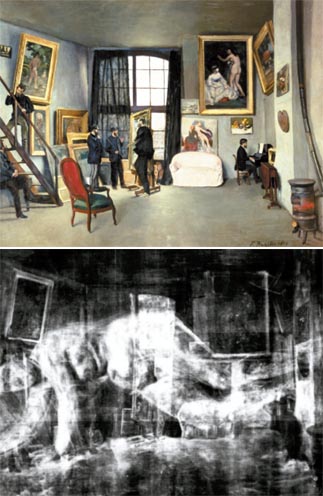X-rays help reveal mysteries of art

“The Artist’s Studio (1870),” an oil painting by Jean Frederic Bazille and an X-ray of the painting. Provided by Art C&R
While arguments over the symbolism attached to the historic painting may never be fully resolved, infrared photographs of the masterpiece offer insight into the mysteries surrounding its creation.
The male figure in the painting stands erect, gently holding the hand of a woman standing next to him. He has a sharp nose and chiseled jaw line.
But an infrared photograph of the painting reveals that his face is distorted - there are multiple eyes, a partially drawn nose and lips all overlapping his face.
“With the help of an infrared ray, we can see that the painter corrected his initial drawing of the man’s face and switched the shape and location of the figure’s eyes, nose and lips,” said Kim Joo-sam, an art restoration expert and director of art at Art C&R, at a press conference last week for the gallery’s new exhibition “Discover Science in Art 2: Mystery Science Expedition.”
“At the time the painting was drawn, Jan van Eyck was known as a technically superb painter,” Kim said. “This is just one of my theories, but based on his reputation, it might be that the man in the portrait saw the finished work and requested that the painter draw his face again - to make his face more handsome.”
The exhibition, held at the Sejong Center for the Performing Arts, aims to reveal the secrets behind the use of state-of-the art technology in art restoration.
Hanging next to prints of some of the most well-known paintings of past centuries are X-ray and laser photographs revealing the corrections the artists made before they completed their work.
The exhibition is the second part in the “Discover Science in Art” series, which is focused on helping children discover the science behind history’s most recognized paintings.
The first exhibition was held from July to August last year.
Visitors to the exhibit will also have a chance to decipher the paintings themselves and spot fakes by comparing the composition of an original artwork and a photo of the painting that has gone through X-ray fluorescence.
Through this process, a chemical analysis is done to determine the paint, paper and other elements used to create it.
*“Discover Science in Art 2: Mystery Science Expedition” will be held every day until March 6 at the Sejong Center for the Performing Arts.
Viewers proceed through the exhibition on an 80-minute tour (Korean only), complete with interactive games.
There is space for 20 people per group during weekdays and 25 people per group during weekends.
Tickets range from 18,000 won ($16.14) to 20,000 won per child and 8,000 won per adult. For more information, call (02) 735-7080 or visit www.sejongpac.or.kr.
By Cho Jae-eun [jainnie@joongang.co.kr]










with the Korea JoongAng Daily
To write comments, please log in to one of the accounts.
Standards Board Policy (0/250자)